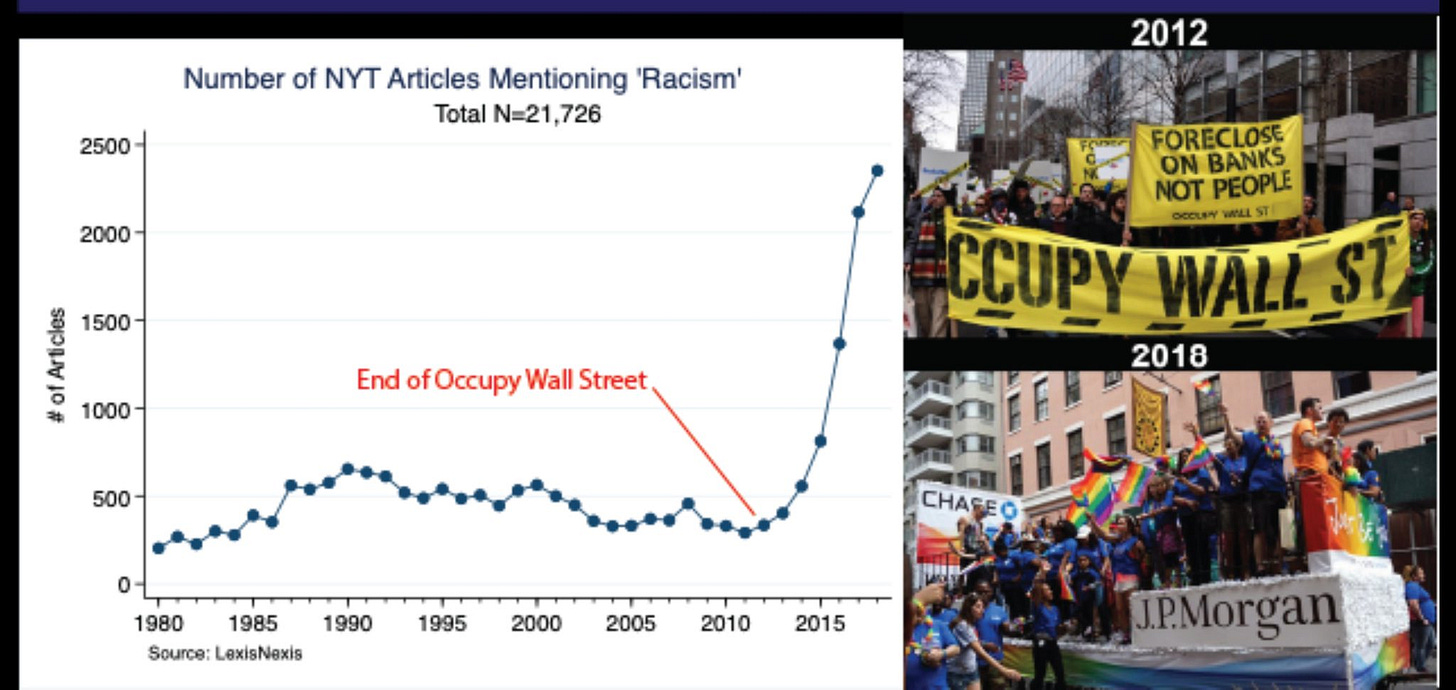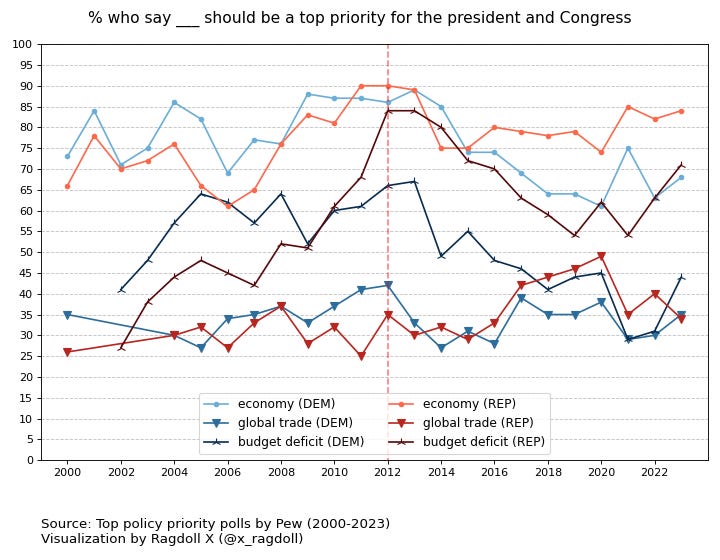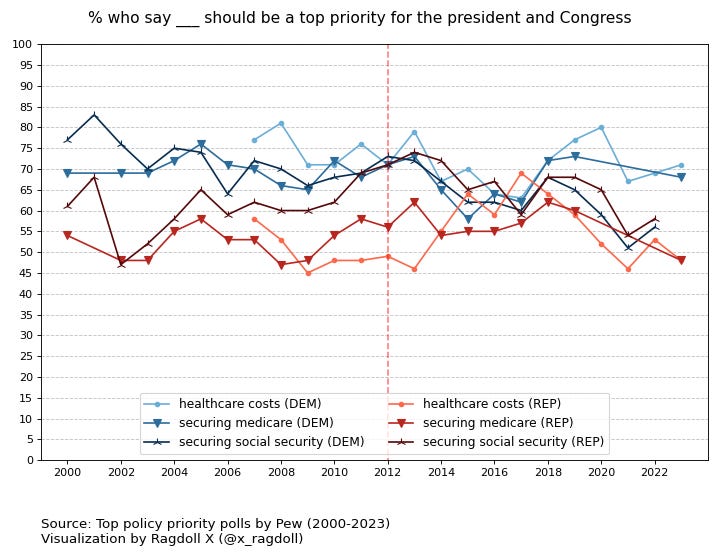You can download the data and code I used to make these graphs on my GitHub.
It’s not uncommon to hear right-wingers and centrists alike decry that the left “focuses too much on racism” and that far less attention is being given to economic issues. They often point to the following graph as evidence that this is the result of some psyop after the Occupy Wall Street protests, to shift the focus away from class consciousness and onto race:
This graph is somewhat misleading however, as the total number of NYT articles completely dwarfs those including the word “racism”, and the number of articles published varied a lot during this time period. While the focus on racism did increase, it was still low.
Instead we should plot the percentage of articles mentioning racism to get a better idea of how much the interest on this topic actually changed. Zach Goldberg, the author of the original graph, attempted to do this, but he wasn’t able to get the exact number of articles published on the NYT through LexisNexis.
For the sake of comparison I’ll also be plotting mentions of the terms “diversity” and “diversity and inclusion”, which Goldberg’s results suggest were mentioned more often than “racism” as you can see below.
I’ll also show mentions of the terms “workers”, “unemployment” and “minimum wage” to get an idea of how often economic issues were covered.
Here we notice several important differences. For starters, these results don’t seem to align with Goldberg’s graphs. This will be in part because he was using LexisNexis, while I’m using the official NYT API. With it we can get the exact number of published articles by simply selecting the year and leaving the query blank, while Goldberg resorted to querying the most commonly used word in the English language (“the”) as a proxy for this. The NYT also seems to include at least a few more articles than LexisNexis. While his results include 21,726 articles mentioning the word “racism”, the official API yielded 22,649 results for the period between 1980 to 2018.
Still, these differences are fairly small and likely didn’t affect the results that much - the main problem is clearly with the “diversity and inclusion” graph. If the conjunction fallacy has taught us anything, a query that includes three words should never give more results than a query that includes only one, so it’s strange that “diversity and inclusion” had seemingly appeared more often than just “diversity”.
As Goldberg himself pointed out he was using quotation marks incorrectly in his queries, which seems to have affected his results.
Using quotations correctly with the NYT API only yielded a few hundred articles which included the phrase “diversity and inclusion”, with the peak being at 149 in 2021. Goldberg’s query may have returned any articles that included either of the words, not the full phrase.
Putting that aside, we get a lot of interesting information from these graphs. We see that racism and diversity were always more popular topics than the minimum wage, and that after 2015 they were also covered more often than unemployment. Still, the word “workers” has always been mentioned more often than the aforementioned terms, and its usage didn’t decrease after Occupy Wall Street, it increased. Mentions of “workers“, “unemployment”, “racism” and “diversity” all peaked at 2020 and have quickly fallen since - this is likely due to the COVID-19 pandemic, along with the murder of George Floyd and subsequent protests.
It’s worth noting that this is a very superficial analysis and doesn’t tell us the topic of the articles or in what context these words were used. For example, the word “diversity” can be used in phrases such as “diversity of opinion” or “diversity of lifestyles”, and the word “workers” can be used in phrases like “black workers”, “immigrant workers” or “workers of color”.
Regardless, these results show that the focus didn’t shift away from class and onto race - both topics and the way they intersect received more attention from the NYT, so to imply that there was some sort of psyop to distract the working class is simply misleading.
But what about the voters?
Still, this doesn’t tell us the whole story. Now we know how often these topics were covered on the NYT, but we still need to look at how much attention Democrats and leftists give to these topics.
There are several polls we can look to for info on this. For example a Gallup poll from 2020 shows that most Democratic voters rated economic issues as important to their vote. 88% rated the economy as extremely or very important, while this number was 63% for the budget deficit and 52% for taxes. Most Democrats also cared about race-related topics, with 89% and 66% respectively rating race relations and immigration as important.
Republicans gave slightly more importance to the economy (93%) and budget deficit (66%) compared to Democrats, and were also more concerned with taxes (70%). Still, we see that a majority rated race relations as important (62%), though this was substantially lower than Democrats, and 63% of Republicans rated immigration as important, a rate similar to Democrats.
However a more recent analysis by Gallup also shows that Republicans have been paying more attention to immigration in the past few years, with 71% in 2023 saying that they’re dissatisfied with the current level of immigration and want it to be decreased. Immigration is obviously also a race-related topic, so while most Democrats give a lot of attention to race, the same is true for Republicans.
One problem with the previous poll is that some of the terms used are rather vague, such as “the economy”. A lot of issues affect the economy, such as unemployment, the minimum wage, unionization rates, taxes, inflation, greedflation, among a variety of other things. So when someone says they care about the economy, this doesn’t tell us much beyond the fact that they might be concerned about whatever combination of economic issues they believe to be important.
Although it was separated into its own category, healthcare can also be considered an economic issue. Healthcare costs are the number one cause of bankruptcy for American families, the U.S. spends more on healthcare compared to other OECD countries despite having worse quality of care, 45,000 Americans die every year because of lack of insurance, 33% report that they or a family member have delayed medical care because they were unable to afford it, and 13.4% say they’ve seen a friend or family member die because they couldn’t afford treatment - and of course, these problems are more pronounced among the poor.
When we account for all of this I think it would be naive to not consider healthcare an economic issue - and we see that 95% of Democrats consider healthcare an important factor on their vote compared to 63% of Republicans. All of this suggests that Democrats care about the economy just as much as Republicans, if not more, and that many Republican voters are also paying attention to race-related issues when making their decision to vote.
We can see similar results in polls from Pew which asked U.S. adults what they believe should be the top priorities for the president and congress.
Here we see that after 2012 interest in the budget deficit decreased for both Democrats and Republicans, with the former being less concerned about it, though it has increased again in 2023. Interest in global trade stayed fairly stable and at similar levels for both groups, and while interest in the economy stayed at about the same level for Republicans, it has somewhat decreased among Democrats, though the majority still considered it a top priority.
When we look at other topics the polls asked about we once again see that Democrats and Republicans treat specific economic issues very differently.
We once again find that Democrats are more concerned with healthcare compared to Republicans, and although the % of Democrats classifying healthcare as a top priority has stayed fairly stable, interest in this topic seem to be on the decline among Republicans since around 2017. Both groups showed similar levels of concern about social security.
The percentage of Republicans and Democrats rating jobs as a top priority is fairly similar and has decreased since around 2012, however we see that Democrats are much more likely to rate the problems of the poor as a top priority compared to Republicans.
When it comes to race, we find that Dems gave greater importance to race relations compared to Reps, although both groups have seen a decrease since 2017. Democrats’ concern about race peaked in 2021 because of the George Floyd protests, but has been on the decline since. By contrast, it’s Republicans who are once again more concerned with immigration, with their interest in this issue having increased since 2012, while for Democrats it has stayed fairly low and stable.
Overall these polls show us that Democrats and Republicans mean very different things when they say “economy”, and Republicans also care a lot about race, just not in the same way as Democrats.
There were a few more issues that the polls asked about which I didn’t include in this post, though you can see all the graphs in my GitHub.
But should we care about racism?
Finally, we must recognize that there is another question embedded in this whole discussion: Should we care about racism?
This talk about shifting narratives and psyops presupposes that an increased focus on race takes away the focus on class, and that we should be paying less attention to the topic of racism. But the race-blind view of racism that was prevalent in the U.S. for many years didn’t solve this problem. The first step in solving a problem is recognizing that it exists in the first place.
“The niggers are just as free as we are.” - Mrs. Miles on the Civil Rights Act, 1964. Sounds familiar?
Racism in the U.S. is still alive and well, affecting a variety of areas in different ways, such as the justice system, education and employment.
A race-blind approach to these problems has never and will never solve them. And as this analysis has hopefully made clear, leftists and liberals are more than capable of caring about more than one issue at a time. Paying attention to and combating racism doesn’t detract from class consciousness, and to imply that it does is, in my opinion, a disingenuous attempt to sweep racism under the rug.
Edit (24/06)
AlbigensianGhoul wanted to see how the frequency of other terms changed over time in the NYT, so I made the graph below.
















